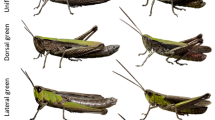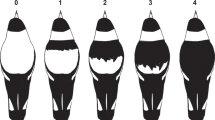Summary
Difficulties in using genetic markers to demonstrate that changes in gene frequency cause fluctuations in the density of animal populations are illustrated. The frequency of chicks with light-coloured down increased during 4 years when population density of red grouse declined and the inherent level of aggressive behaviour of adults increased. Variations in aggressive behaviour and down colour of individuals within years, however, were not related.
Similar content being viewed by others
References
Chitty D (1967) The natural selection of self-regulatory behaviour in animal populations. Ecol Soc Aust 2:51–78
Gaines MS, Gorman WL (1985) Are transferrin and leucine aminopeptidase electromorphs reliable genetic markers in the prairie vole, Microtus ochrogaster? Oecologia (Berlin) 66:74–76
Henderson BA (1975) The genetics of natural populations of red grouse (L. lagopus scoticus Lath.) at different densities. Ph.D. thesis, University of Aberdeen
Henderson BA (1977) The genetics and demography of a high and low density of red grouse Lagopus l. scoticus. J Anim Ecol 46:581–592
Hutt FB (1949) The Genetics of the Fowl. McGraw-Hill, New York
Krebs CJ (1985) Do changes in spacing behaviour drive population cycles in small mammals? Symp Brit Ecol Soc 25:295–312
Krebs CJ, Gaines MS, Keller BL, Myers JH, Tamarin RH (1973) Population cycles in small rodents. Science 179:35–41
McGovern M, Tracy CR (1981) Phenotypic variation in electromorphs previously considered to be genetic markers in Microtus ochrogaster. Oecologia (Berlin) 51:276–280
McGovern M, Tracy CR (1985) Phusiological plasticity in electromorphs of blood proteins in free-ranging Microtus ochrogaster. Ecology 66:396–403
Moss R, Watson A (1985) Adaptive value of spacing behaviour in population cycles of red grouse and other animals. Symp Brit Ecol Soc 25:275–294
Moss R, Kolb HH, Marquiss M, Watson A, Treca B, Watt D (1979) Aggressiveness and dominance in captive cock red grouse. Aggressive Behavior 5:59–84
Moss R, Watson A, Rothery P, Parr R (1984) Inherent changes in the body size, viability and behaviour of a fluctuating red grouse (Lagopus lagopus scoticus) population. J Anim Ecol 53:171–189
Siegel S (1956) Nonparametric Statistics for the Behavioural Sciences. McGraw-Hill, New York
Watson A, Moss R, Rothery P, Parr R (1984) Demographic causes and predictive models of population fluctuations in red grouse. J Anim Ecol 53:639–662
Author information
Authors and Affiliations
Rights and permissions
About this article
Cite this article
Moss, R., Watson, A. Changes in the down colour of chicks during a population decline in red grouse. Oecologia 73, 598–600 (1987). https://doi.org/10.1007/BF00379422
Received:
Issue Date:
DOI: https://doi.org/10.1007/BF00379422




